A trio of Japanese spots, revisited. More or less.
Tori Tori, Ecuador 1175, Recoleta. First reviewed back in February 2017, this, being the city’s only yakitori bar, is one of my “go to” spots for… yakitori. Coming up on three years, I thought it might be nice to bring it back to your attention….
I almost always start off with one of their excellent selection of onigiri, stuffed rice balls – this one filled with mentaiko, spicy fish roe, one of my favorites. They have about a dozen different fillings on offer. They’ve all been great!
Not being up for one of their combos of yakitori, which vary between three and fourteen skewers, plus onigiri, but with no say in what you get, I tend to order, what I want. Started off with the bondiola, a mix of pork shoulder interleaved with slices of onion, beautifully cooked and spiced with a classic tare sauce.
Swiftly followed a trio of chicken skewers – the first, chicken liver, the second, dark meat of chicken capped with kimchi and green onions, and last, chicken breast slathered with yuzu-kosho, the spicy lime and chili condiment that’s all the rage these days.
Finished off with “dessert”, of crunchy, crispy, crackly chicken skin doused with lemon juice and sprinkled with sea salt. A fitting ending for a light meal!
The skewers run around, if I remember, 150-200 pesos ($2.50-$3) each, and the onigiri are 110 pesos, or $2 – and the quality is fantastic. I was a little surprised when ordering some shochu, the rice wine, that for more than the price that most Japanese or Korean places charge you for a whole small bottle (150ml), here, they serve about two fingers of it poured over an ice cube in a glass – I think it was 250 pesos, or about $4, what you might pay at a decent bar for a good mixed cocktail. That felt a bit rip-off-y. They also still only take cash, which is a pain, because the bill can add up. It’s also illegal – federal law requires restaurants to take cards in Argentina, at most they can limit them to “domestic only”.
Second recent visit for a popup by takoyaki specialists Dotonbori – I hadn’t heard of them, but apparently many had, as there was a line when the place opened at 7pm, and it just got longer and longer. I opted for “to go”… which wasn’t really on offer, but I guess being a regular has its perks. I’m not good in small, cramped spaces that are packed with way too many people, so if to go hadn’t have been an option, I’d have just gone, and missed out on…
…excellent takoyaki, some of the best I’ve had here in BA, and among the better ones I’ve had elsewhere. They look a little deflated after carrying them home in a plastic wrapped container, but trust me, they were delicious! (180 pesos, $3)
I had visions of “ikayaki” being a calamari version of the same fried balls, but turns out that it’s simply a grilled whole calamar, lacquered with tare sauce and then topped with the same toppings as the octopus balls. A little chewy for my tastes, I think it just spent too long on the grill. (180 pesos, $3)
And, as always, some onigiri, they were offering a special for the night of unagi, or lacquered eel, one of my favorite sushi toppings, and one that we don’t generally see here, so this was a nice treat. (110 pesos, $2, each)
Dotonbori has regular popups, it looks like, according to their Instagram feed, at least a couple per week, so check them out to see where and when they’ll be next!
Izakaya Niji, Iberá 2424, Nuñez. It’s been over three years since my first and only visit to this spot. I don’t know why, I loved it the first time, and its certainly one of the best traditional Japanese spots in the city. Part of it is probably because they’re only open from 6-9:30 p.m., and they’re quite strict about it. If you show up around 8.30 or 9, they let you know in no uncertain terms that the kitchen closes by 9:30 and you’re expected to be out no later than 10. Apparently the majority of their business is after office hours, local Japanese businessmen, who come in, have a couple of drinks, snack on the food, and then go home. By the time we arrived at 8 pm, no one was there, and it stayed that way until we left, promptly, a few minutes before 10.
I love their sake service – a lovely glass teapot, with a separate chamber for ice, to keep it cold.
The biggest change over the three years, is that they have both expanded their menu, significantly, and, translated it all into Spanish for those who don’t read Japanese. Once again, we received a little amuse to start the evening, this time a small block of a Japanese style omelette, tamago, on a skewer, with a rather sweet dipping sauce, and a strange little blob of a sweet potato with a bit of fried tofu on the side. Didn’t quite get that.
Once again, amazing gyoza, and I love that they do these the real traditional way all browned together, and flipped, so that both sides are browned. Juicy and delicious, not to be missed.
Being in a bit of a takoyaki mindframe, I pimped for their version. Very, very strange. Still quite tasty, all the flavors and ingredients are there, but they do it as a sort of scrambled pancake of tempura batter, octopus, and green onion, and then dollop the sauces and bonito flakes across it like a sort of pizza. It was good, but I like the little fried balls you can pick up and pop in your mouth.
An excellent version of buta kimchi, the pork belly and kimchi stir-fry that’s the Japanese version of Korean jjyeok bokkeum. Usually it’s a quite toned down version of kimchi, and the version that we often get at Ichisou fits that mold. This one, the kimchi has a solid kick, as does the dish. We worked up at least a mild sweat getting to the bottom of the dish. Part of the heat may have been that opposed to the Ichisou version which balances the spice with a mildly sweet, lacquered char siu style pork, this used simple stir-fried pork belly.
Biggest surprise here was that they charge a cubierto, for, really, nothing – there’s no bread service or anything like that – maybe it’s for the amuse, but then I’d rather just not have it, at 75 pesos per person it’s not high, but why pay a buck and change for a blob of sweet potato and a cube of omelette that you don’t really want? The other dishes all ran between 400-460 pesos, so $7-8 range, and well worth it.
Ikkon by Pikkei, Montevideo 1061, Recoleta. In yet another turn over of ownership of this spot, what used to be a branch of Dashi, and then became something, which became Pikkei, which was a nikkei style Japanese-Peruvian spot that I quite liked when I visited, but came to loathe for their poor delivery service and phone attitude, is now changing hands again, after not much over a year open. Apparently keeping the Pikkei name recognition (given my experiences, maybe not a good idea), but with a new owner and sushi chef. [Closed permanently during the 2020 pandemic quarantine.]
The menu is far more extensive than it used to be, though less nikkei style, and more sort of free wheeling international influences. At the same time, they haven’t expanded their fish offerings – they still only offer salmon, tuna, sole, prawns, and octopus, in various combinations, and on the eve of my visit, they didn’t have any tuna, which not only cut out the basic nigiri or sashimi, but also all the various combination rolls and such that used tuna.
I started off with their version of a classic Peruvian dish (they still have some), pulpo al olivo, and have to say that it was pretty much the best version of this dish I think I’ve ever had. It was also huge – I wasn’t at all expecting a platter like this, and the rest of what I ordered quickly became pigeonholed into dividing things up into what I would eat in place, and what I would have them pack up to go. Pricey having thought about it as an individual dish, but this is shareable, and at the odd price of 762 pesos (most of their prices seem to end in either 2 or 8, maybe it’s a superstition thing), or just shy of $13, it’s not bad for the size.
Their white samurai roll consists of four pieces, each a prawn and a block of tamago, the Japanese omelette, wrapped in sole, dusted with spicy togarashi and drizzled with lemon. An interesting idea, but didn’t quite win me over, mostly because the prawns were really overcooked. (368 pesos, $6)
And, unfortunately, they were likewise overcooked in the nigiri sushi pieces. I did really like the salmon skin pieces – the skin was so crisp you could break it like a cracker – I’m not sure if they dehydrated it and then broiled it, or some other technique, but it didn’t have that sometime chewiness that you get, which, depending on how much of it there is, can be unpleasant. (420 and 322 pesos, $7 and $5)
Overall, I left with mixed feelings (and a box of half of this stuff, which I ate the next day). I can’t say I put it in my winner’s circle.
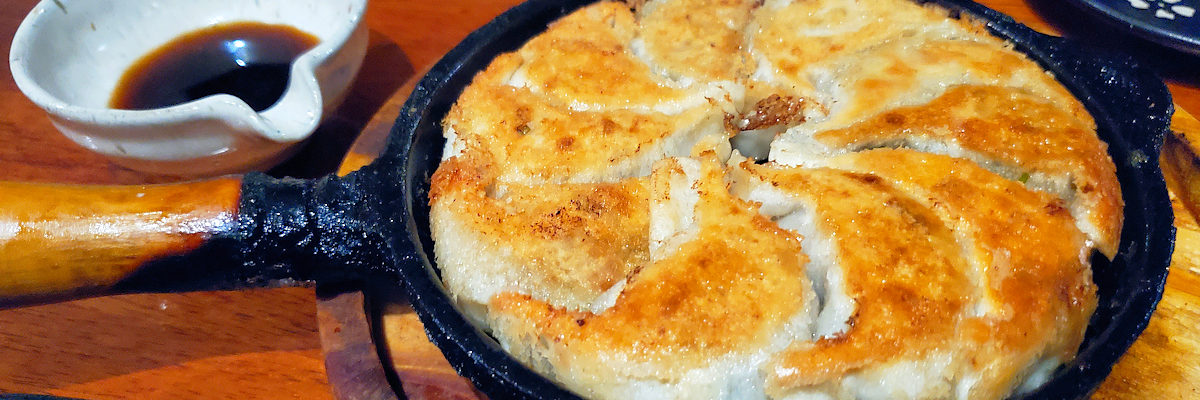
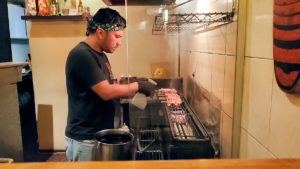
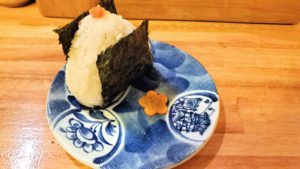
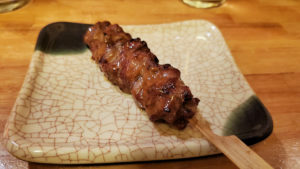
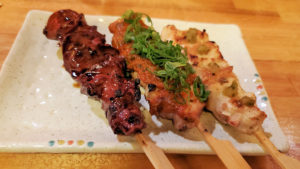
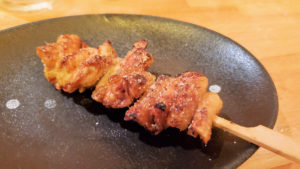
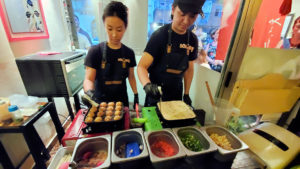
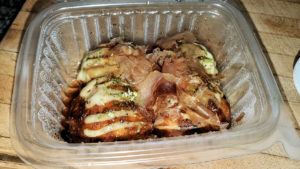
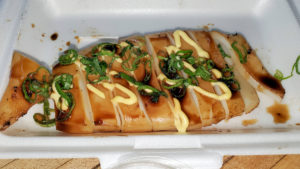
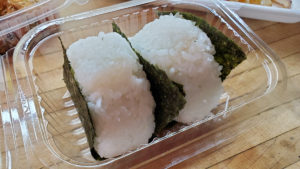
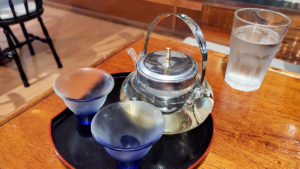
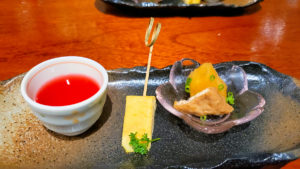
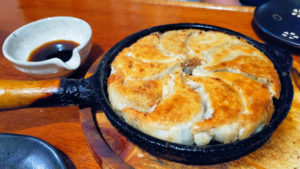
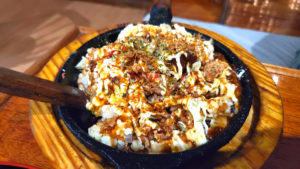
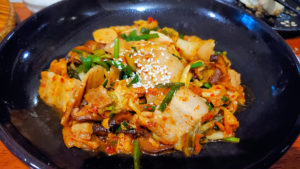
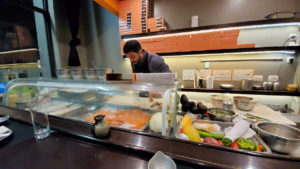
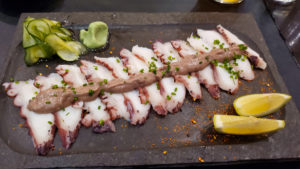
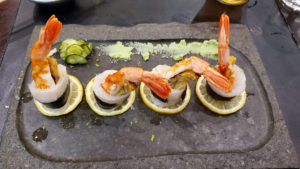
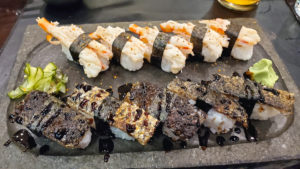
[…] Pikkei, Montevideo 1061, Recoleta – It’s probably unfair of me to pop into this place just a day or so after returning from Lima, where I had amazing sushi and fantastic nikkei creations, because, let’s face it, no one in Buenos Aires has, to date, even remotely approached that level of sushi quality, and that includes the offshoots of Lima-based groups, like La Mar and Osaka. Let alone the gouging level of prices here versus there. But, I happened to walk by this spot (which took over the space that Dashi vacated at the end of last October), and thought I’d give it a try. [Sold to new owner and chef in late 2019, who have sort of kept the name, calling it “Ikkon by Pikkei“] […]
[…] seaweed, sesame seeds, salt, sugar, and sometimes more. Yum. Hmm… better than the ones at Tori-Tori, which have been my go-to onigiris in town. I’ll probably still mostly stick with the […]